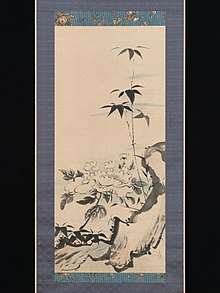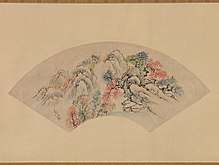Ike Gyokuran
| Ike Gyokuran | |
|---|---|
 牡丹に竹図 - Peony and Bamboo by a Rock, Metropolitan Museum of Art | |
| Native name | 池玉瀾 |
| Born |
Machi (町) 1727 |
| Died | 1784 |
| Residence | Gion |
| Other names | Tokuyama Gyokuran |
| Occupation | Painter, calligrapher, and poet |
| Spouse(s) | |
Ike Gyokuran (池玉瀾, 1727–1784) was a Japanese Bunjinga painter, calligrapher, and poet.[1] She was famous in Kyoto, Japan, during her lifetime, and she remains a celebrated artist in Japan. [2][3]
Her parents gave her the birth name Machi (町). As a child, she was given the art-name Gyokuran, most likely by her painting teacher Yanagisawa Kien (1707–1758).[4] Gyokuran married fellow artist Ike no Taiga, and she is best known by her married name Ike Gyokuran. Her surname before marriage was Tokuyama, and she is also known as Tokuyama Gyokuran.[3]
Early life and education
Gyokuran began to learn to paint at an early age under famous literati painter Yanagisa Kien, who was a regular at her mother's teahouse[5]. It is likely that he was the one to introduce her to Ike no Taiga, who was almost among his students.
Gyokuran's husband Taiga taught her the painting style of the nanga (Southern painting) movement,[5] a Japanese version of a Chinese style. Gyokuran, in turn, taught her husband poetry in the Japanese waka style, in which she was proficient.[4]

The couple were renowned for their eccentricity. They created art together, mutually influencing each other, and were also known to play music together for leisure, as equals. This was highly unusual in a country where women were still widely considered inferior to men. It is noted that Gyokuran did not shave her eyebrows, as was customary for married women at the time.[6]
Career and impact

Gyokuran painted folding screens and sliding doors, handheld scrolls, hanging scrolls, and fan paintings.[1] "It was exceptionally rare for women in 18th century Japan to be painters," according to Anne d’Harnoncourt, director of the Philadelphia Museum of Art.[5] Gyokuran and her husband Taiga dedicated themselves to making art, living on little money, and sometimes collaborating on art pieces.[2] She lived with Taiga in a small studio next to the Gion shrine in Kyoto. Gyokuran created folding screens, handheld scrolls, hanging scrolls, and fan paintings.[1] She also often painted small scenes, on which she inscribed her poems in calligraphy.
In 1910, her verses were printed alongside a woodblock print of the Matsuya teahouse at the Gion Shrine in the Gion sanjo kashū (Poem Collection of the Three Women of Gion).
To this day, during Kyoto's yearly Jidai Matsuri (Festival of the Ages), young women dress up as prominent female figures of Kyoto history, including Gyokuran.
Awards and honors
Some of Gyokuran's works are designated Japanese National Treasures and Important Cultural Properties.[1]
References
- 1 2 3 4 Philadelphia Museum of Art. "Philadelphia Museum of Art – Exhibitions – Ike Taiga and Tokuyama Gyokuran: Japanese Masters of the Brush". www.philamuseum.org. Retrieved 2016-03-05.
- 1 2 Smith, Roberta (2007-05-18). "Ike Taiga and Tokuyama Gyokuran: Japanese Masters of the Brush – Art – Review". The New York Times. ISSN 0362-4331. Retrieved 2016-03-05.
- 1 2 Fischer, Felice (2007). Ike Taiga and Tokuyama Gyokuran: Japanese Masters of the Brush. Philadelphia, PA: Philadelphia Museum of Art. p. 33. ISBN 978-0-87633-198-9.
- 1 2 Fister, Patricia (1988). Japanese Women Artists, 1600–1900. University of Kansas: Lawrence, Kansas: Spencer Museum of Art. p. 74. ISBN 0-913689-25-4.
- 1 2 3 Villarreal, Ignacio. "Ike Taiga and Tokuyama Gyokuran". artdaily.com. Retrieved 2016-03-05.
- ↑ Fister, Patricia (1990). Flowering in the Shadows: Women in the History of Chinese and Japanese Painting. United States: University of Hawaii Press. p. 261. ISBN 0-8248-1149-6.